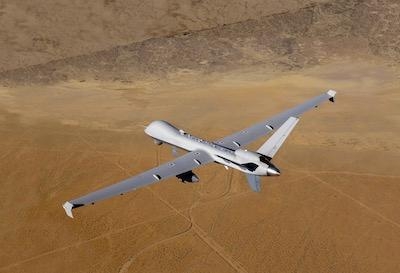Wed, Jan 15, 2020
Brake System Design Also Contributed To The Accident
The U.S. Air Force has released a report stating the cause of an accident involving an MQ-9A Reaper unmanned aircraft which departed a runway at an undisclosed location on September 3, 2018.

According to the report, the Mishap Aircraft (MA) was assigned to the 27th Special Operations Wing (SOW) at Cannon Air Force Base (AFB), New Mexico, and was flown by a Launch and Recovery Element (LRE) crew deployed to the undisclosed location from the 489th Attack Squadron (ATKS), 432nd Operations Group, 432nd Wing, Creech Air Force Base, Nevada.
The Mishap Crew (MC) received an “Engine – metal detected” red warning 10 minutes after takeoff, turned back towards the field and established an orbit to begin fuel dumping. Nine minutes later the engine oil pressure exceeded the limit of 126 pounds per square inch (psi) and the MC received a red warning. Per Aeronautical Systems Incorporated ASI-11114, Flight Manual, the MC elected to make an immediate straight-in landing using engine out procedures due to the possibility of catastrophic engine failure. Upon touchdown the propeller failed to go into reverse and the MA departed the prepared surface; according to Aeronautical Systems Incorporated ASI-11114, Flight Manual, the MQ-9A relies primarily on reverse thrust to slow and stop the aircraft upon landing.
After departing the runway, the MA caught fire and was destroyed with all modifications and four missiles. The resulting loss was valued at $12,726,187. There were no fatalities or damage to private property.
The Abbreviated Accident Investigation Board President found, by the preponderance of the evidence, the cause of the mishap to be the design of the engine. Further, the Board President found, by the preponderance of the evidence, the delay between engine Spectrometer Oil Analysis Program (SOAP) samples being taken and analyzed, as well as the design of the MQ-9A brake system, to be substantially contributing factors.
(Image from file)
More News
Aero Linx: JAARS Nearly 1.5 billion people, using more than 5,500 languages, do not have a full Bible in their first language. Many of these people live in the most remote parts of>[...]
'Airplane Bounced Twice On The Grass Runway, Resulting In The Nose Wheel Separating From The Airplane...' Analysis: The pilot reported, “upon touchdown, the plane jumped back>[...]
"Burt is best known to the public for his historic designs of SpaceShipOne, Voyager, and GlobalFlyer, but for EAA members and aviation aficionados, his unique concepts began more t>[...]
"Polaris Dawn, the first of the program’s three human spaceflight missions, is targeted to launch to orbit no earlier than summer 2024. During the five-day mission, the crew >[...]
There Are SO Many Ways To Get YOUR Aero-News! It’s been a while since we have reminded everyone about all the ways we offer your daily dose of aviation news on-the-go...so he>[...]
 ANN's Daily Aero-Linx (05.04.24)
ANN's Daily Aero-Linx (05.04.24) NTSB Final Report: Quest Aircraft Co Inc Kodiak 100
NTSB Final Report: Quest Aircraft Co Inc Kodiak 100 Aero-News: Quote of the Day (05.04.24)
Aero-News: Quote of the Day (05.04.24) Aero-News: Quote of the Day (05.05.24)
Aero-News: Quote of the Day (05.05.24) Read/Watch/Listen... ANN Does It All
Read/Watch/Listen... ANN Does It All



